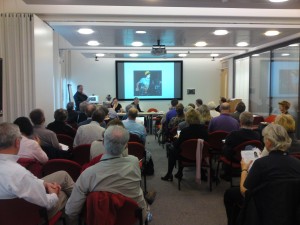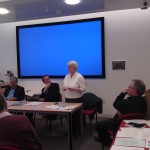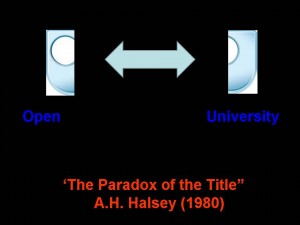Open to people and places
Despite the project’s best efforts to encourage contributions from the University outside Walton Hall, the first session, chaired and introduced by Project Sponsor Professor David Vincent, concentrated more on how open the University had been to people, rather than to places.
University Archivist Ruth Cammies opened the session with a presentation on ‘the personal stories of the Open University’ as revealed though the Oral History Project, which ended in summer 2010 having conducted over 70 interviews with academic, administrative, and regional staff, students and alumni.
Those present were treated to a small sample of the collection looking at some of the more unique areas of the University, including the creation of OU modules, working with the BBC, designing home experiment kits and telephone tutorials.
The next speaker was Ormond Simpson, Visiting Fellow at the University of London International Programme and former Senior Lecturer at the OU. The presentation focussed on the University’s record in retaining its students and the possible impact of technological advances.
Simpson also drew attention to ‘the paradox of the title’, about the difficulty of being both ‘open’ and a ‘university’, an appropriate discussion for the birthday of Jennie Lee, who has been particularly credited with ensuring that the OU made no compromise on academic standards in becoming a university, and with establishing the principle of the OU having no entry qualifications.
 The final speaker in this session was Alan Woodley, a Research Fellow in IET who talked about the make-up of the student body and how this had changed over 40 years. He outlined what had been measured, how the OU compared to the rest of the higher education sector and discussed whether or not the figures reflected the University’s ‘openness’ or otherwise. Some interesting features of this included the rise in the number of ‘young’ students; the rise in women studying, but only reflecting the rise of women in HE more broadly; and the significant rise in those not in paid work for an unspecified reason (see table 4).
The final speaker in this session was Alan Woodley, a Research Fellow in IET who talked about the make-up of the student body and how this had changed over 40 years. He outlined what had been measured, how the OU compared to the rest of the higher education sector and discussed whether or not the figures reflected the University’s ‘openness’ or otherwise. Some interesting features of this included the rise in the number of ‘young’ students; the rise in women studying, but only reflecting the rise of women in HE more broadly; and the significant rise in those not in paid work for an unspecified reason (see table 4).
| Table 4: The labour market status of new OU undergraduates (2005-09) | |||||
| 2005 | 2006 | 2007 | 2008 | 2009 | |
| % | % | % | % | % | |
| In full-time work/self-employed | 64 | 61 | 61 | 58 | 53 |
| In part-time work/self-employed | 14 | 14 | 15 | 14 | 14 |
| Looking after the home/family | 8 | 9 | 8 | 8 | 9 |
| Retired from paid work | 3 | 2 | 3 | 3 | 3 |
| Doing unpaid voluntary work | 1 | 1 | 1 | 1 | 1 |
| Unable to work : long-term sickness/disability | 3 | 3 | 3 | 3 | 4 |
| Unemployed and looking for a job | 4 | 4 | 4 | 4 | 7 |
| Not in paid work for some other reason | 4 | 5 | 6 | 8 | 10 |
| All “Not in paid work “ | 22 | 25 | 25 | 28 | 33 |
Source: Open University statistics
The following discussion was wide-ranging covering the varying motivations of OU students; the range of opportunities offered to marginalised groups over the years; and the historic staff profile of the University and its impact.
The absence of appropriate representation from the OU regions and nations is an issue that the project would welcome, and intends to create, opportunities to redress through alternative channels. For copies of the papers or presentations email history-of-the-ou@open.ac.uk.
 The morning finished with a fascinating introduction to the BBC written archive by BBC multimedia archivist Jacquie Kavanagh. Jacquie had brought documents from the time of the OU’s foundation including correspondence with ministers and a memo from the then Controller of BBC2 David Attenborough. She reminded those present of the historic commitment of the BBC to education and the importance of the relationship with the BBC, particularly in those early days.
The morning finished with a fascinating introduction to the BBC written archive by BBC multimedia archivist Jacquie Kavanagh. Jacquie had brought documents from the time of the OU’s foundation including correspondence with ministers and a memo from the then Controller of BBC2 David Attenborough. She reminded those present of the historic commitment of the BBC to education and the importance of the relationship with the BBC, particularly in those early days.


February 6th, 2011 at 1:41 pm
In your blog post above you included a Table 4, probably by Alan Woodley. This table shows an expected increase following the financial crisis in those looking for employment, but very curiously an increase in those not in any paid work ‘for any reason’. These include full-time students registered at another university, incarcerated criminals, plus the super-rich who need not work. Can you please elucidate on these data – specifically the year-on-year increase of 4% (2005), 5% (2006), 6% (2007), 8% (2008) and 10% (2009). Surely we must unwrap these numbers, and NOT add them to the house-bound, handicapped, and job-seekers. Comments please ? You can cite my name and email, OU ID =R4500194.